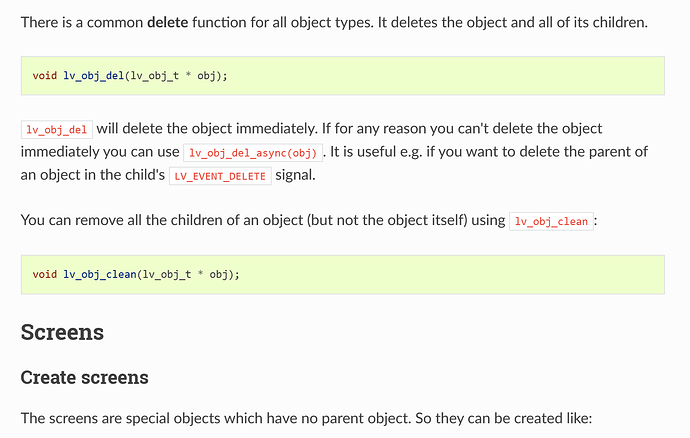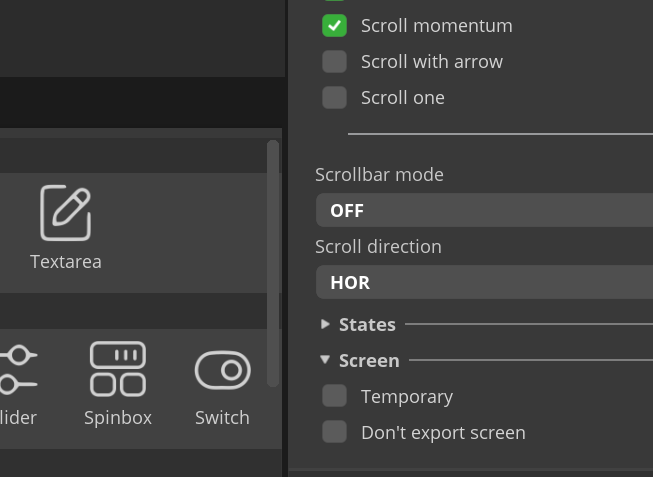Description
I am writing an application that is using at least three screens to perform actions and display data.
I have searched the internet and I have found many people asking what is the correct way to do this, but I have not come across an example that works for me.
At present, every time I try to change screens, the ESP32 restarts with:
“Guru Meditation Error: Core 1 panic’ed (InstrFetchProhibited). Exception was unhandled.”
What MCU/Processor/Board and compiler are you using?
Espressive ESP32-S3-WROOM-1
What LVGL version are you using?
Currently using 8.3.0 - I have also tried the latest
What do you want to achieve?
I am looking to put together an example that I can use and share with others that are having the same problem as me.
What have you tried so far?
Too many examples to mention here…
Code to reproduce
Add a code snippet which can run in the simulator. It should contain only the relevant code that compiles without errors when separated from your main code base.
The code block(s) should be formatted like:
//******************************* MY CODE *******************************************
//screen1 = lv_scr_act();
screen1 = lv_obj_create(NULL);
lv_obj_t * button1 = lv_btn_create(screen1);
lv_obj_add_event_cb(button1, button_event_cb, LV_EVENT_CLICKED, NULL);
lv_obj_set_size(button1, 170, 80);
lv_obj_set_pos(button1, 32, 100);
lv_obj_t * label1 = lv_label_create(button1);
lv_label_set_text(label1, "Button 1");
lv_obj_t * button2 = lv_btn_create(screen1);
lv_obj_add_event_cb(button2, button_event_cb, LV_EVENT_CLICKED, NULL);
lv_obj_set_size(button2, 170, 80);
lv_obj_set_pos(button2, 249, 100);
lv_obj_t * label2 = lv_label_create(button2);
lv_label_set_text(label2, "Button 2");
screen2 = lv_obj_create(NULL);
//lv_scr_load(screen2);
lv_obj_t * button3 = lv_btn_create(screen2);
lv_obj_add_event_cb(button3, button_event_cb, LV_EVENT_CLICKED, NULL);
lv_obj_set_size(button3, 170, 80);
lv_obj_set_pos(button3, 249, 100);
lv_obj_t * label3 = lv_label_create(button2);
lv_label_set_text(label3, "Button 3");
screen3 = lv_obj_create(NULL);
//lv_scr_load(screen3);
lv_scr_load(screen1);
//lv_scr_load(screen2);
// lv_scr_load(screen3);
printf("Setup done\n");
}
}
void loop()
{
lv_timer_handler(); /* let the GUI do its work */
delay(5);
unsigned long currentMillis = millis();
if (currentMillis - previousMillis >= interval) {
previousMillis = currentMillis;
//espnow_senddata();
}
}
void button_event_cb(lv_event_t *event){
//lv_obj_t *screen1;
lv_obj_t *screen2;
//lv_obj_t *screen3;
lv_obj_t *btn = lv_event_get_target(event);
lv_obj_t * label = lv_obj_get_child(btn, 0);
const char * text = lv_label_get_text(label);
printf ("Button_Touched: %s \n", text);
if(strcmp(text, "Button 2") == 0) {
printf ("Goto Screen: %s \n", text);
//lv_scr_load(scn2);
//lv_obj_clean(lv_scr_act());
//lv_scr_load(screen2);
//lv_scr_load(lv_scr_act());
printf ("Clean Screen1:\n");
lv_obj_clean(screen1);
printf ("Delete Screen1:\n");
lv_obj_del(screen1);
//printf ("Clean Screen2:\n");
//lv_obj_clean(screen2);
//printf ("Delete Screen2:\n");
//lv_obj_del(screen2);
printf ("Load Screen3:\n");
lv_scr_load(screen3);
//Comment
}
}
// void button2_event_cb(lv_event_t *event)
// {
// // if(event == LV_EVENT_CLICKED) {
// lv_scr_load(lv_scr_act());
// // }
// }
21224][E][Wire.cpp:�ESP-ROM:esp32s3-20210327
Build:Mar 27 2021
rst:0x1 (POWERON),boot:0x8 (SPI_FAST_FLASH_BOOT)
SPIWP:0xee
mode:DIO, clock div:1
load:0x3fce3808,len:0x44c
load:0x403c9700,len:0xbe4
load:0x403cc700,len:0x2a38
entry 0x403c98d4
[ 129][I][esp32-hal-psram.c:96] psramInit(): PSRAM enabled
[ 701][I][esp32-hal-i2c.c:75] i2cInit(): Initialising I2C Master: sda=19 scl=20 freq=100000
[ 701][W][Wire.cpp:301] begin(): Bus already started in Master Mode.
[ 704][E][esp32-hal-gpio.c:102] __pinMode(): Invalid pin selected
E (582) gpio: gpio_set_level(226): GPIO output gpio_num error
E (597) gpio: gpio_set_level(226): GPIO output gpio_num error
E (603) gpio: gpio_set_level(226): GPIO output gpio_num error
[ 781][E][esp32-hal-gpio.c:102] __pinMode(): Invalid pin selected
Setup done
Button_Touched: Button 1
Button_Touched: Button 1
Button_Touched: Button 1
Button_Touched: Button 2
Goto Screen: Button 2
Clean Screen1:
Delete Screen1:
Load Screen3:
Guru Meditation Error: Core 1 panic'ed (InstrFetchProhibited). Exception was unhandled.
Core 1 register dump:
PC : 0x00000205 PS : 0x00060030 A0 : 0x82002cb7 A1 : 0x3fceba30
A2 : 0x00000205 A3 : 0x3fceba74 A4 : 0x3fc973a8 A5 : 0x00000000
A6 : 0x00000000 A7 : 0x00000000 A8 : 0x8204a9ad A9 : 0x3fceba00
A10 : 0x3fc973a8 A11 : 0x3fceba74 A12 : 0x3fca4720 A13 : 0x3c0508e7
A14 : 0x3c050831 A15 : 0x3c050841 SAR : 0x0000000a EXCCAUSE: 0x00000014
EXCVADDR: 0x00000204 LBEG : 0x400556d5 LEND : 0x400556e5 LCOUNT : 0xfffffff0
Backtrace: 0x00000202:0x3fceba30 0x42002cb4:0x3fceba50 0x42002e5e:0x3fceba70 0x420091de:0x3fcebab0 0x42009739:0x3fcebae0 0x42009bff:0x3fcebb00 0x42006429:0x3fcebb20 0x4200646d:0x3fcebb50 0x420029ac:0x3fcebb70 0x42002c65:0x3fcebc30 0x420024ae:0x3fcebc50 0x42002e02:0x3fcebc70 0x42002e5e:0x3fcebc90 0x4200344e:0x3fcebcd0 0x42003b04:0x3fcebd00 0x42019000:0x3fcebd50 0x420026bf:0x3fcebd80 0x4202b251:0x3fcebda0
#0 0x00000202:0x3fceba30 in ?? ??:0
#1 0x42002cb4:0x3fceba50 in event_send_core at .pio/libdeps/esp32-s3-Sunton_800x480/lvgl/src/core/lv_event.c:458
#2 0x42002e5e:0x3fceba70 in lv_event_send at .pio/libdeps/esp32-s3-Sunton_800x480/lvgl/src/core/lv_event.c:75
#3 0x420091de:0x3fcebab0 in lv_obj_refresh_style at .pio/libdeps/esp32-s3-Sunton_800x480/lvgl/src/core/lv_obj_style.c:187
(inlined by) lv_obj_refresh_style at .pio/libdeps/esp32-s3-Sunton_800x480/lvgl/src/core/lv_obj_style.c:167
#4 0x42009739:0x3fcebae0 in lv_obj_set_local_style_prop at .pio/libdeps/esp32-s3-Sunton_800x480/lvgl/src/core/lv_obj_style.c:275
#5 0x42009bff:0x3fcebb00 in lv_obj_set_style_x at .pio/libdeps/esp32-s3-Sunton_800x480/lvgl/src/core/lv_obj_style_gen.c:56
#6 0x42006429:0x3fcebb20 in lv_obj_set_x at .pio/libdeps/esp32-s3-Sunton_800x480/lvgl/src/core/lv_obj_pos.c:62
#7 0x4200646d:0x3fcebb50 in lv_obj_set_pos at .pio/libdeps/esp32-s3-Sunton_800x480/lvgl/src/core/lv_obj_pos.c:48
#8 0x420029ac:0x3fcebb70 in lv_scr_load_anim at .pio/libdeps/esp32-s3-Sunton_800x480/lvgl/src/core/lv_disp.c:232
#9 0x42002c65:0x3fcebc30 in lv_disp_load_scr at .pio/libdeps/esp32-s3-Sunton_800x480/lvgl/src/core/lv_disp.c:84
#10 0x420024ae:0x3fcebc50 in button_event_cb(_lv_event_t*) at .pio/libdeps/esp32-s3-Sunton_800x480/lvgl/src/core/lv_disp.h:207
(inlined by) button_event_cb(_lv_event_t*) at src/main.cpp:256
#11 0x42002e02:0x3fcebc70 in event_send_core at .pio/libdeps/esp32-s3-Sunton_800x480/lvgl/src/core/lv_event.c:467
#12 0x42002e5e:0x3fcebc90 in lv_event_send at .pio/libdeps/esp32-s3-Sunton_800x480/lvgl/src/core/lv_event.c:75
#13 0x4200344e:0x3fcebcd0 in indev_proc_release at .pio/libdeps/esp32-s3-Sunton_800x480/lvgl/src/core/lv_indev.c:980
#14 0x42003b04:0x3fcebd00 in indev_pointer_proc at .pio/libdeps/esp32-s3-Sunton_800x480/lvgl/src/core/lv_indev.c:384
(inlined by) lv_indev_read_timer_cb at .pio/libdeps/esp32-s3-Sunton_800x480/lvgl/src/core/lv_indev.c:101
#15 0x42019000:0x3fcebd50 in lv_timer_exec at .pio/libdeps/esp32-s3-Sunton_800x480/lvgl/src/misc/lv_timer.c:313
(inlined by) lv_timer_handler at .pio/libdeps/esp32-s3-Sunton_800x480/lvgl/src/misc/lv_timer.c:109
#16 0x420026bf:0x3fcebd80 in loop() at src/main.cpp:217
#17 0x4202b251:0x3fcebda0 in loopTask(void*) at C:/Users/dpunt/.platformio/packages/framework-arduinoespressif32/cores/esp32/main.cpp:50
ELF file SHA256: 4db1e7f78ea52109
Rebooting...
Screenshot and/or video
If possible, add screenshots and/or videos about the current state.

